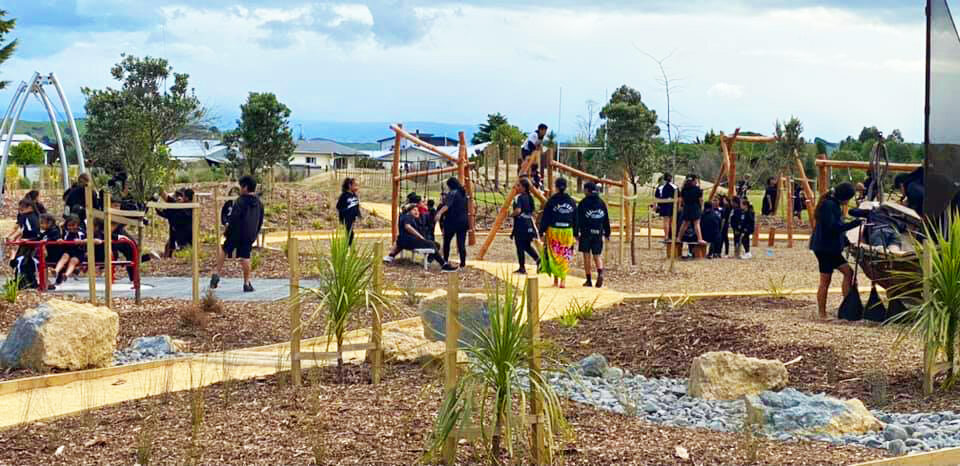The Kimi Ora project
By Claudia Boyo
The Kimi Ora Project was identified as a key priority for the ongoing success and enrichment of students and provided the opportunity to create strong links to the broader community of Flaxmere.
The aim of the project was to localise the curriculum, and encourage outdoor learning to become a day to day activity as many kids learn through doing rather than language.
Kimi Ora school principal Matt O’Dowda told LAA that the project was the culmination of many wananga with kids, community, hapu, kaumatua and iwi.
I designed the project using stories relating to the 50% Maori, 50% Pasifika cohort to inform the design. The design was crafted to take people on a journey by systematically sharing the movement of many of the children’s ancestors or even their own journeys, from Pacific villages to voyages across the pacific ocean and their place of settlement, the Heretaunga plains.
Te Ao Maori and Pasifika concepts and region-specific narratives were used to shape and influence natural playspaces, producing a unique type of school grounds that facilitated learning and play through a landscape.The design also incorporated a range of areas such as a covered picnic area, a skate bowl and a bike path, that were of benefit to the local community, enabling the site to become a community hub outside of school hours.
Ngāti Kahungunu Fortified Pa Playspace. Carvings by Nathan Foote
The narrative
The court space around the school buildings was designed as an outdoor meeting and performance space that created the feel of a Pacific village.
The large central playground then told the story of the children’s ancestors navigating across the pacific ocean using different play equipment, catering to a range of abilities, to create a series of posts, nets and lines that are seen trailing from behind a waka.
Other elements nearby, such as the star compass water play area and mussel skate bowl, illustrate the role star navigation and kai moana played in the success of these voyages.
Tangaroa Fishing Playground. Carving by Nathan Foote
The maze-like flax field and forest boardwalk provided children with more naturalised and independent play spaces which reference the different microclimates in the region but provide children with different physical challenges and learning opportunities relating to the school curriculum.
Other spaces such as the Rongoa garden and loose parts play area were also designed for outdoor classroom learning.
Rather than a ‘playground’, it is about creating a curriculum grounded in Te Ao Maori and Pasifika.
The opening of the School was one of the most special days of my life. Seeing kids, who had before had a concrete court, some dry grass and a small playground (between 100 of them), be able to play in the new school grounds was a very fulfilling and significant moment for me.
People generally only feel as good as their surroundings. A child's day to day surroundings generally sets the standard for quality of life they strive for as they grow. It felt really special to give these kids an environment that they really deserved and I hope that the Kimi Ora landscape shows those kids that they should expect more from life and that they can dare to strive for it as they progress into adulthood.
The site connects kids and whanau back to whakapapa and the purakau of Kahungunu while also being future focussed, Kimi Ora school principal Matt O’Dowda says.
The experience completely reinforced that I want to dedicate my career to trying to roll this initiative out across New Zealand for low decile schools in low socioeconomic areas.
*Kimi Ora school principal Matt O’Dowda told LAA: “I came across Claudia’s work after finding an image online. From our first conversation, we were never going to work with anyone else. The way she thinks very much aligned with our kaupapa Maori philosophy.
“Through wananga and the sharing of purakau, Claudia brought the concept to life. It was exactly what our kids, whanau and community wanted.”




